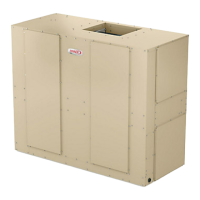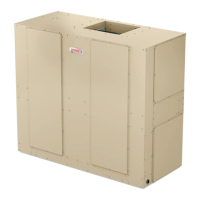Page 61
TABLE 13. Outdoor Control 7-Segment Display Alert Codes - Compressor
System fault and lockout codes take precedence over system status codes (cooling, heating operating percentages or defrost/dehumidication). Only
the latest active fault or lockout codes are displayed (if present). If no fault or lockout codes are active, then system status codes are displayed. Alert
codes are also displayed on the S30/S40 thermostat on systems installed with the S30/S40 thermostat.
Alert
Codes
Inverter
Code
Inverter LED Flash
Code (number of
ashes)
Priority Alarm Description Possible Causes and Clearing Alarm
Red LED Green LED
E 433 29 2 ashes 9 ashes
Moderate
/ Critical
The inverter
has detected a
compressor over-
current condition.
Error occurs when compressor peak phase current is greater
than 28A. Inverter issues code 14 rst and slows down to try
to reduce the current. If the current remains high, outdoor
unit compressor and fan stop. Antishort cycle is initiated. If
condition occurs 5 times within an hour, system is locked out.
To clear, disconnect power to the indoor unit (24VAC power
source to the outdoor control) which will power o the outdoor
control and will open the outdoor unit contactor, which
interrupts power to the inverter and then re-apply power.
E 439 12 1 ash 2 ashes Moderate
Compressor
slowdown due to high
input current.
Input current is approaching a high limit. Compressor speed
automatically slows. The control continues sending the
inverter speed demanded by the thermostat. The control sets
indoor CFM and outdoor RPM to values according to demand
percentage rather than the actual Hz. Alarm is automatically
clear.
E 440 13 1 ash 3 ashes Minor
Heat sink
temperature is
approaching limit.
The compressor
speed automatically
slows to reduce heat
sink temperature.
The control sets
indoor CFM and
outdoor RPM to
values according to
demand percentage
rather than the actual
Hz.
Alarm is
automatically cleared.
This error code is primarily for informational purposes as
the inverter controls the compressor speed to operate within
design parameters. Typically the inverter will make a minor
speed reduction of 4 Hz (approximately a 5-6% speed
reduction) for a brief period of time and to reduce the heat sink
temperature and will then resume normal operation. This may
occur at high outdoor temperatures (above 110ºF) for brief
periods of time (3 – 4 minutes) and is normal and expected
operation of the inverter controlling the compressor safely
within design parameters.
The inverter nned aluminum heat sink is located on the
back side of the inverter in the condenser air stream. f the
alert code 440 occur frequently, especially at lower outdoor
temperatures, check the heat sink for debris that may reduce
heat transfer or possible obstructions that may impact air ow
across the heat sink.
The inverter will begin to briey reduce the compressor speed
when the heat sink temperature rises above 185ºF and will
allow the inverter to resume the requested compressor
demand speed once the inverter heat sink reaches 176ºF.
The heat sink temperature, compressor speed in Hertz & the
Inverter Compressor Speed Reduction status (“On” or “O ”)
notication can be viewed under the outdoor unit Diagnostics
section of the thermostat dealer control center on units
installed with an S30/S40 thermostat.
E 441 14 1 ash 4 ashes Minor
Compressor
slowdown due to high
compressor current.
Compressor current
is approaching limit.
The compressor
speed automatically
slows. The control
sets indoor CFM
and outdoor RPM to
values according to
demand percentage
rather than the
actual Hz. Alarm is
automatically cleared
This error code is primarily for informational purposes as the
inverter controls the compressor to operate within design
parameters. Alert code 441 typically occurs at startup as the
compressor as the currently increases rapidly during startup.
The inverter will reduce the compressor speed by 4 hz
and slow the compressor ramp up speed to the requested
compressor demand (capacity). This is normal and expected
operation of the inverter to control the compressor within
design parameters. In most cases the alert code 441 does
not require any additional service or diagnostic procedures.
E441 may also occur if the system is operating at high
pressures.
E 600 N/A N/A N/A Critical
Compressor has
been cycled OFF by
utility load-shedding
function.
Load-shedding function: Provides a method for a local utility
company to limit the maximum power level usage of the
outdoor unit. The feature is activated by applying 24 volts AC
power to the L and C terminals on the outdoor control.

